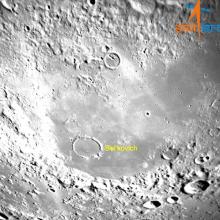Listen to today's episode of StarDate on the web the same day it airs in high-quality streaming audio without any extra ads or announcements. Choose a $8 one-month pass, or listen every day for a year for just $30.
You are here
Moon and Venus
The Moon creeps up on the brightest point of light in the night sky tonight: Venus, the “evening star.” Venus stands above the Moon as they come into view. The gap between them will shrink as they set, a couple of hours later.
The Moon was “new” on Tuesday, as it crossed between Earth and the Sun, starting a new month-long cycle of phases. At sunset tonight as seen from the United States, it’s about two and a half days into that cycle — it’s two and a half days “old.” It’ll grow 27 days older before the cycle ends at April’s new Moon.
This evening, the Sun will light up only about seven percent of the side of the Moon that faces our way. It’s daylight in that slim crescent, and nighttime everywhere else.
A lunar night lasts about two Earth weeks. But on the Earth-facing side, the nights are quite bright. They’re lit up by earthshine — sunlight reflecting off of Earth. It’s just like moonshine here on Earth, but much brighter. Earth is much bigger than the Moon, and about three times more reflective. So a full Earth is dozens of times brighter than a full Moon. That’s a view to look forward to for the astronauts who are expected to travel to the Moon later in this decade and beyond.
Right now, Earth is more than 90 percent illuminated, casting its bright blue glow across the lunar landscape. From here on Earth, that glow is easily visible on the Moon’s nightside — the ghostly light of Planet Earth.
Script by Damond Benningfield






